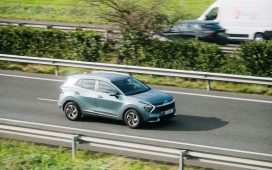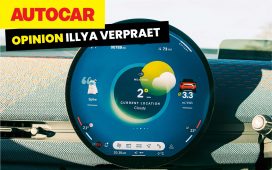Fresh off its stunning success with the IONIQ electric vehicle series, Hyundai is bouncing back into the automotive ring for another round with the newly unveiled INSTER. This time the focus is squarely on urban drivers in the market for a maneuverable, parkable car the size of a compact sedan but with practical load-hauling features. To gild the zero-emission lily, Hyundai has also paid attention to some small but interesting details.
INSTER And The Electric Vehicle Of The Future
First, the bad news for those of you looking for the Inster in the US. You’re out of luck. Hyundai shared a press release with CleanTechnicahere on Thursday, when it unveiled the Inster A-segment subcompact at the 2024 Busan International Mobility Show. The release stated that “INSTER will launch first in Korea this summer, followed by Europe, the Middle East, and Asia Pacific in due course.”
That seems to leave the US out of the loop, but I reached out to Hyundai for the scoop on North American availability anyways, so here’s hoping. In the meantime, you can get all the details on what we’re missing from the Hyundai website. Skipping over all the facts and figures, let’s just say that Hyundai knows something important about the electric vehicle of the future, namely, that it is still a vehicle.
As urban centers become more cramped, crowded, and car-free, an electric vehicle will be just as unwieldy as any other car for daily commuting. Congestion pricing adds another wrinkle to the traffic headaches. That’s where the last-mile solution comes in. The idea is to get close to the destination, park the car in a convenient spot before getting stuck in traffic, then go the rest of the way by bike, scooter, foot, train, or bus.
The Inster has plenty of room to load a folding bike or scooter inside, and Hyundai makes a point of pointing out that the car’s bi-directional charging feature makes it convenient to use an electric bike or scooter.
“External and internal Vehicle-to-Load (V2L) functionality provides power for external devices (110V/220V), allowing bi-directional charging without requiring additional equipment. This enables customers to freely use or charge devices such as electric bicycles, scooters and camping equipment,” Hyundai explains.
An Electric Vehicle Is Still A Vehicle, Part II
Hyundai is also paying attention to another important aspect of the electric vehicle-as-a-vehicle, and that is overall sustainability beyond zeroing out carbon emissions. Car parts are car parts, whether the vehicle is electric or not, and Hyundai is among the automakers working to incorporate more recycled and bio-based materials.
“The INSTER’s exterior features black high-gloss recycled paint, which replaces the carbon black pigment traditionally used in black paint with a coloring made from recycled waste tires,” Hyundai notes.
“Recycled polyethylene terephthalate (PET) from bottles and bio-polypropylene material extracted from sugarcane are used inside,” they add.
That could mean just about anything, so I’ll get back to Hyundai again for the specifics. Here in the US, automakers have been cautious about introducing bio-based and recycled car parts, though they have definitely shown an interest. Ford, for example, has exploring alternative materials for years, with one recent example being harness clips made from upcycled ocean plastic.
Interiors and exteriors aside, microparticle pollution from tire wear and tear is a concern for all automakers, zero emission or not. Some innovative solutions are emerging in that area, so keep an eye out for more on that.
On Sustainability, Smaller Is Better
The size of the vehicle also counts for something in the sustainability area. Here in the US, automakers still insist on marketing an electric vehicle like any other car, meaning that bigger is better, men prefer bigger cars, and men make most of the car-buying decisions — or not, as the case may be.
Last year our friends over at Wired noted that automotive design is still heavily male-centric even though a clear majority of new cars in the US are bought by women, or are bought under the influence of women. Nevertheless, male-centered design has also carried over to the electric vehicle field (see truck, Cyber).
Cars.com has assembled some data supporting the notion that men have a “much more emotional” approach to the car buying experience than women, leading them to prefer larger vehicles. Women tend to prioritize practicality and cost, leading to more demand for smaller vehicles, and for used vehicles as well.
Bigger means more supply chain inputs and energy resources that are often both superfluous and redundant, depending on the needs of the driver, but smallness is not the image that most US automakers want to project. Stepping down in size puts automakers at risk of being slotted into the category of something cute and fuzzy, like a baby bunny rabbit.
As if on cue, “Hyundai Inster Is a Cutesy EV,” is the first part of the headline for a review of the Inster by a member of the automotive press, followed by this observation: “This adorable little crossover packs a modern interior and a 113-hp electric motor into a teensy-weensy package….”
Look Out, Here Comes The Scout Electric Vehicle
Pardon me while I wipe myself down with a tissue. Can’t an urban electric vehicle just be small, relatively sustainable, and last-mile compatible, and leave it at that?
We’ll see soon enough. If the Inster doesn’t get over to the US fast, Ford might beat Hyundai to the punch with its not-so-secret “skunkworks” electric vehicle project, aimed at drivers seeking an affordable zero-emission ride.
In the latest news on that venture, last week The Detroit News scooped word that Ford plans to open a new electric vehicle R&D center in Long Beach, California. “It’s an outgrowth of the Dearborn automaker’s ‘skunkworks’ group, a small team under the leadership of Tesla Inc. veteran Alan Clarke purposefully set apart in California to work without disruption,” noted TDN reporter Breana Noble.
Noble also cited industry experts who surmise that Ford will need “a new mindset and approach” to reach its goal of a price point less than $25,000. That includes Bank of America Corp. analyst John Murphy, who did not seem overly optimistic. He advised that “most Americans prefer larger SUVs and trucks over a smaller vehicle likely to be offered on a platform as low as $25,000.”
Do they? Earlier this year, Kelley Blue Book observed that “it’s clear something is changing in America.”
“Every segment that has seen its market share grow so far in 2024 is compact or smaller,” KBB added.
The newly announced joint venture between Volkswagen and Rivian also suggests that an interest in scalability potentially opens the door to more choices for smaller-vehicle fans in the US.
Then there’s the California startup TELO, which is tapping into the Kei-car craze with its mini electric pickup truck, and the Japanese firm HW Electro with its scaled-down Puzzle electric delivery van. Hold on to your hats….
Follow me @tinamcasey on Bluesky, Threads, Instagram, and LinkedIn
Photo (cropped): Hyundai introduces the new Inster electric vehicle for scaled-down, zero emission city driving (courtesy of Hyundai).
Have a tip for CleanTechnica? Want to advertise? Want to suggest a guest for our CleanTech Talk podcast? Contact us here.











